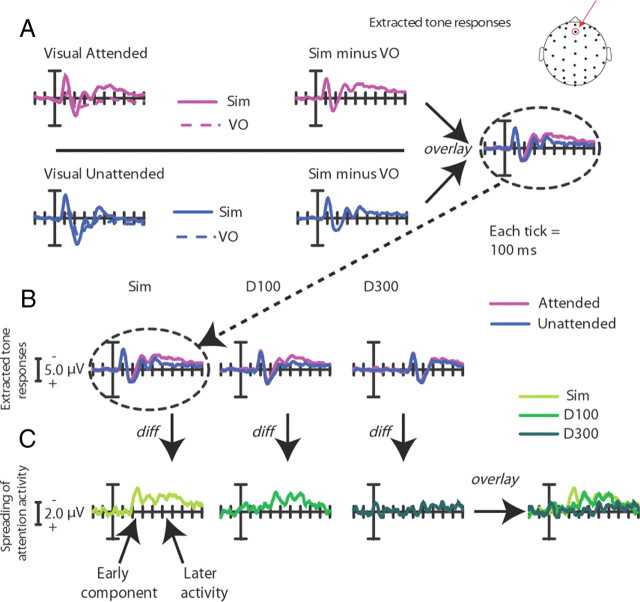Figure 4.
Multisensory spread-of-attention activity. The difference wave contrasts shown here allow for the removal of ERP activity associated with the pure sensory visual or attentional visual effects, isolating the extracted auditory ERP under each of the different multisensory attentional contexts. Note the change in scale in A and B versus C. All traces are for frontal site Fz (top). A, Extracted auditory ERP responses for the simultaneous condition. These are derived by calculating the ERP difference waves for the attended-visual simultaneous condition (Sim) minus the attended-visual visual-only condition (VO; top), and for the corresponding unattended-visual simultaneous minus unattended-visual visual-only conditions (bottom). These difference waves obtained for the extracted activity to the central tone occurring in the presence of an attended lateral visual stimulus and in the presence of an unattended lateral visual stimulus were compared (right). B, Extracted auditory ERP responses for all the SOA conditions. Responses for the same central auditory stimuli occurring in the context of the attended versus unattended lateral visual stimulus were calculated for each condition (simultaneous, delay-100, and delay-300). Each of these extracted-ERP difference waves was obtained in the same manner that is shown in A for the simultaneous condition. C, The difference waves between the extracted auditory responses, shown in B above, when they occurred in the context of an attended minus an unattended lateral visual stimulus for each of the three SOA conditions, overlaid. The simultaneous condition showed the greatest attentional difference, with the delay-100 condition showing a slightly diminished attentional difference, shifted in time by ∼100 ms. In sharp contrast, the delay-300 displayed little differences between the extracted auditory response in the context of the attended versus the unattended visual stimuli, thus showing little of the attentional spreading effect.

